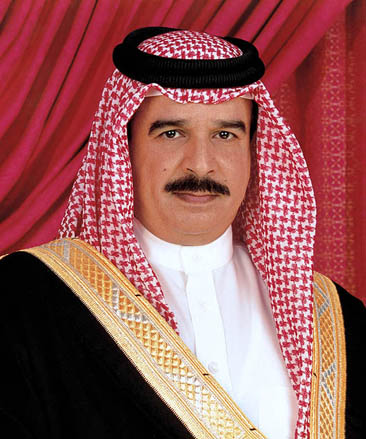Bahrain
مملكة
البحرين

H.M. King Hamad ibn Isa Al Khalifa
حمد بن عيسى آل خليفة
Reign: 6 March 1999 – present
Grand Master of: Order of Al-Khalifa and Khalifiyyeh Order of Bahrain
Royal Coat of Arms  Royal Coat of Arms
Royal Coat of Arms
History
Bahrain is the Arabic term for "two seas", referring to the freshwater springs that are found within the salty seas surrounding it. Bahrain has been inhabited since ancient times. Its strategic location in the Persian Gulf has brought rule and influence from the Assyrians, Babylonians, Persians, and the Arabs, under whom the island became Islamic. Bahrain may have been associated with Dilmun which is mentioned by Mesopotamian civilizations.
During its history it was called by different names such as Awal, then Mishmahig, when it was a part of the Persian Empire. From the 6th to 3rd century BC, Bahrain was included in Persian Empire by Achaemenian dynasty. From the 3rd century BC to the arrival of Islam in the 7th century AD, Bahrain was controlled by two other Iranian dynasties of Parthians and Sassanids. By about 250 BC, the Parthian dynasty brought the Persian Gulf under its control and extended its influence as far as Oman.
Because they needed to control the Persian Gulf trade route, the Parthians established garrisons in the southern coast of Persian Gulf. In the 3rd century AD, the Sassanids succeeded the Parthians and held the area until the rise of Islam four centuries later. Ardashir, the first ruler of the Iranian Sassanian dynasty marched forward on Oman and Bahrain, and defeated Sanatruq. At this time, Bahrain incorporated the southern Sassanid province covering the Persian Gulf's southern shore plus the archipelago of Bahrain.
The southern province of the Sassanid Empire was subdivided into the three districts of Haggar (now al-Hafuf province, Saudi Arabia), Batan Ardashir (now al-Qatif province, Saudi Arabia), and Mishmahig (which in Middle-Persian/Pahlavi means "ewe-fish"). Until Bahrain adopted Islam in 629 AD, it was a center of Nestorian Christianity. Early Islamic sources describe it as being inhabited by members of the Abdul Qays, Tamim, and Bakr tribes, worshiping the idol Awal.
Resources:
http://www.medals.co.uk
http://en.wikipedia.org/wiki/King_of_Bahrain